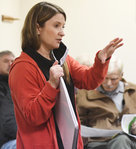Belle officials questioned directors of the Missouri Department of Natural Resources (DNR) and State Parks on Jan. 20 about grant opportunities and maintenance plans connected to the Rock …
This item is available in full to subscribers.
We have recently launched a new and improved website. To continue reading, you will need to either log into your subscriber account, or purchase a new subscription.
If you are a current print subscriber, you can set up a free website account by clicking here.
Otherwise, click here to view your options for subscribing.
Please log in to continue |
|






Belle officials questioned directors of the Missouri Department of Natural Resources (DNR) and State Parks on Jan. 20 about grant opportunities and maintenance plans connected to the Rock Island Trail.
Following the meeting, Mayor Josh Seaver told The Advocate, “I am more excited now about the trail than I have ever been. We are ready to get started.”
DNR and State Parks invited community representatives from Owensville, Bland, Belle, Rosebud and Gerald to attend a public forum meeting at the Owensville Scenic Regional Library, followed by an assessment meeting with state officials at Owensville City Hall.
State Parks reported 83 visitors to the hour-and-a half long meeting at the library, and about 35 officials at the assessment meeting.
Seaver, aldermen Ken Stanfield and Fred Bethmann and Public Works Director Tony Baretich were all present at the assessment meeting to ask questions.
Bethmann, whose father and brother own Bethmann Farms located on First Street, spoke with state department officials about issues his family has experienced with clean-up around the trail before and after it was cleared.
Bethmann asked who the city could contact if they had issues.
“I’ll be proactive in everything that affects the city, but I’m also questioning what happens outside the municipalities,” Bethmann said. “What’s a point-of-contact we need to follow up with to see when and where something can be done?”
David Kelly, Missouri State Parks director, said State Parks and DNR officials in the room would be the city’s point-of-contact.
“We work with our maintenance staff or work with landowners and allow them to do it,” Kelly said. “The timing of it, we don’t have staffing yet, but we talked to someone in Eldon the other day and we can come out and look at it. If it is something (the city or citizens) can do and want to do then we issue an agreement with them and allow them to do it.”
Mike Sutherland, deputy director of DNR, said he thinks the city of Belle will find State Parks and DNR much more responsive than the previous owner of the trail.
Bethmann also asked about places where the railroad formerly ran over the roadway. He specifically mentioned the intersection from Highway 28 to First Street where street crews have paved continuously over the old railroad ties for so many years that the bump has become a site impediment from the intersection of First Street and Osage County Road 738 as well from First Street to Highway 28.
“When you evaluate Belle, where First Street travels over the right-of-way, they didn’t remove the rails or the ties and that pavement has been overlaid and overlaid until that bump is tall as can be and it’s a traffic hazard and an eyesore,” Bethmann said. “We could never get a response out of Ameren about how we could handle that.”
Kelly said those things were parts they would want to know about and take care of to be good neighbors.
Baretich asked questions about the maintenance of the trail itself.
“As far as maintenance goes, I think we are kind of unique in the Belle, Bland, and Owensville stretch where all coscenicmmunities are on board to do this,” Baretich began. “Do we get any kind of assistance, to maintain in between us, quicker? Because if Owensville does their stretch, Bland does their stretch and we do our stretch we’re going to have at least that. I get you guys don’t have a crew put together and I don’t want to generate more work for my crew or Owensville crew, but at some point, is there, would there, could there be funding for us to maybe stretch our arms a little bit until you guys take this over?”
Kelly said DNR does have some limited funds to help.
“Yeah, but ours are more limited,” Baretich said.
Kelly said that until DNR has additional appropriations coming, what they have now is limited.
“If I understand it correctly, the cities would take more ownership of this,” Stanfield asked. “It’s not like you are going to hand this off, you are actually going to take more responsibility, more maintenance and more cost to keep the trail maintained long-term.”
Kelly said within the city limits they are asking cities to help. DNR doesn’t own any buildings along the Rock Island, which makes storing maintenance equipment impossible. They prefer to work with cities to maintain parts inside the communities.
“There is not a lot to do within the city because most of the time you guys are already doing it — and the restrooms,” Kelly said.
Removing trees and mowing the corridor happens a lot on the Katy Trail, but Kelly thinks the demographic of the Rock Island Trail will make it different.
“That’s why we have the agreement, and not every agreement is going to be exactly the same,” Sutherland said. “That doesn’t mean we aren’t going to take our own significant piece of that responsibility. Honestly, if the appropriation would revert, $69 million dollars goes a little ways. I think that will put us in a position, if it does get approved, to where we will still need partnerships and still want towns along the way to have identities to do all those things.
“When you talk about those resources, make sure you aren’t left hanging with more responsibilities than you can afford. We don’t have any expectations and didn’t think it was right that taxpayers in your communities should have to pay for things that are outside of your communities.”
Sutherland said they can create contracts and agreements to provide resources where DNR could make it an advantage for the city to help.
“We want to be creative thinkers and we truly believe that it will be a benefit to your town and a true asset to the state,” Sutherland said.
Kelly said agreements may be a different model than others. DNR is working towards a $2.7 million grant from the Department of Economic Development moving forward and developing trails.
“We are looking at the sustainability of all of this after the trail is built,” Kelly said. “An agreement where we can provide resources without having to have a bunch of staff. We are not interested in developing partnerships that are unsustainable and 10 years after the trail is developed they are wondering ‘why do we have to do this?’ We want this to make sense for both the communities and State Parks.”
Chryssa Niewald with Missouri Rock Island, Inc. (MoRIT) asked how much of the Katy Trail had such maintenance agreements.
DNR and State Parks officials said they were hoping to run more towards that model of agreement.
State officials also told those attending that there are several options for trail grant funding right now, including the Recreational Trails Program (RTP) grant.
Kelly asked Melonie Smith, DNR deputy regional director for the northern region of State Parks, to touch on grant programs that are available.
Smith had passed out packets to city officials when the meeting first began, which included information about the Recreational Trails Grant Program (RTP).
“There are links to other grants on the back,” Smith said. “The Recreation Trails Program grant closes on Feb. 16.”
RTP grants require a 25 year commitment.
“There’s information about all kinds of other grants,” Smith continued. “LWCM and water conservation fund grants.”
RTP is an 80/20 percent match grant and is very sought after. Other grants Smith mentioned included a 50 percent grant and 50 percent match.
Stanfield asked officials about an RTP grant the city was forced to abandon in 2018 due to no one from State Parks or DNR responding to requests to extend the grant.
The city of Belle had been awarded the RTP grant under former governor Jay Nixon’s administration, but with the change in party leadership, couldn’t get a go-ahead from the Grietens’ administration to begin the project.
It approached the six-year completion date requirement, and city officials sent multiple requests for an extension without response. Sutherland was sent to speak with Belle officials in 2018 about returning the grant after the extension deadline had passed.
“A few years ago we had a grant for DNR to put gravel (on the trail) through our town,” Stanfield began. “That money was taken away from us. Is it going to be harder to get back?”
Sutherland said no.
“Part of the reason that grant was not followed through with was because ownership of the corridor was not figured out yet and it just didn’t work,” Sutherland said. “We made the commitment at that time (to not penalize the Belle community) because that didn’t work out (not completing grants can be held against the applicant during the next application round), but that’s not the case because that was a very unique circumstance.”
Sutherland said that Belle would be able to apply for the RTP grant the same as anyone else.
“I do have to tell you that because it is an 80/20 match it is very competitive and every year we get more applications than there are recipients,” Sutherland said. “It would still go in with that competitiveness.”
Sutherland said the timing issues have been resolved, the state has accepted the corridor and they have moved on.
John Paul Quick of Owensville asked officials if the city of Belle would be able to automatically get their grant back. Officials said no, the city of Belle would have to reapply.
“Because of the addition of the Rock Island Trail and because of the interest from communities, there is going to be even more demand for that,” Sutherland said.
Quick asked if the state would take into account the cities of Belle, Bland, Owensville, Gerald and Rosebud working together to develop their trails, would the grant people take that into account to give them money?
Owensville Mayor John Kamler asked Quick to clarify if he wanted to fill out a grant application in partnership with the other communities.
Rebecca McKinstry, deputy general counsel for DNR answered the question.
“The maximum amount that a grant recipient can request from the grant program is $250,000,” said McKinstry. “So depending on how much it costs, putting in four applications and trying to get bigger pieces is a part of it.”
McKinstry said DNR doesn’t score the grant applications, they give it to the Trails Advisory Board, representatives of different trails, equestrian or bicycling trails, across the state.
“If you want to include letters of support to go with each other’s grant applicants, I think they would love that,” McKinstry said. “I would be happy to review anyone’s (RTP grant) application before it goes to review. Those will be due on Jan. 28.”
McKinstry added that anyone intending to apply in the future may send in their grants anytime to be reviewed.
Maries R-2 School officials were not present at the assessment meeting.
Superintendent Dr. Lenice Basham said Jan. 18 that she was not sure she would attend the meeting.
“I am still unsure what our plans are in regards to this opportunity,” Basham said in response to an email.
Communities were asked to set up individual assessment meetings with Smith to discuss more opportunities with DNR and State Parks.
Seaver said Tuesday afternoon that he plans to set up an assessment meeting with State Parks and has already visited with Meramec Regional Planning Commission (MRPC) about grant opportunities.